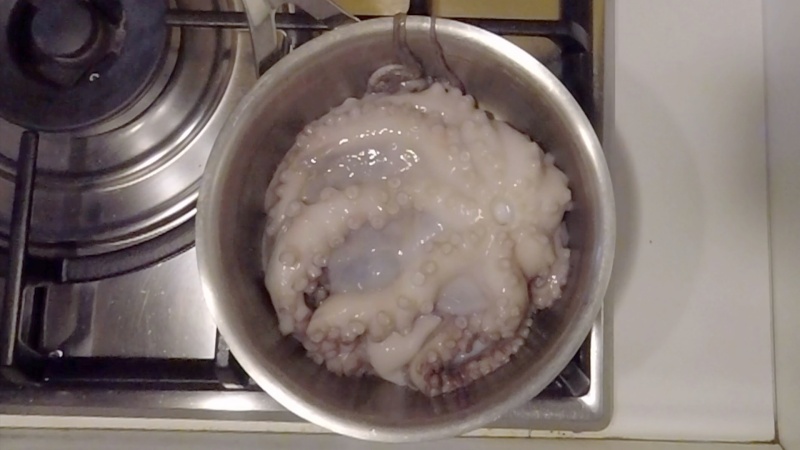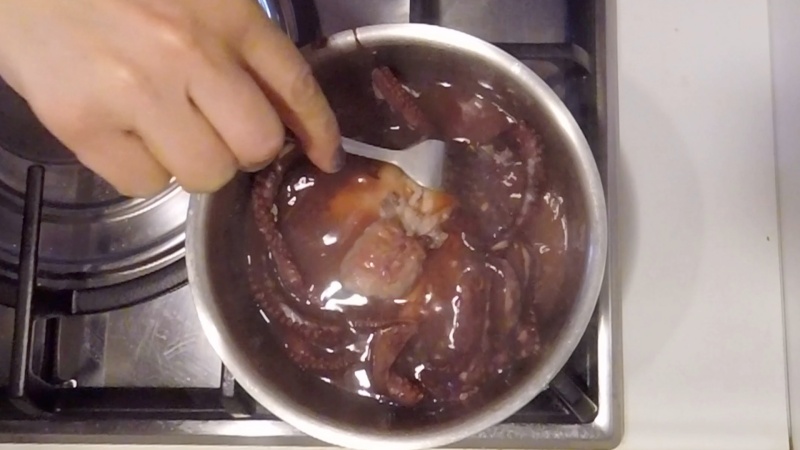Cooking octopus in its own juices—rather than boiling it in water—is an excellent method for achieving tender and flavorful results. Octopus is naturally rich in juices, so after just a couple of minutes in a closed pot over the heat, it begins to release a substantial amount of water, without the risk of burning. The key advantage of boil octopus without water is to preserve its flavor: octopus cooked in its own juices is more flavorful, allowing for reduced salt in the seasoning.
Octopus boiled without water becomes exceptionally tender and can be enjoyed in salads or various dishes, such as quickly seared on the grill and served with mashed potatoes or a special dressing. This method of cooking octopus in its own juices is widely embraced in southern Italy, particularly in Puglia, where octopus takes the spotlight in numerous recipes.
To achieve this cooking method, you’ll need a thick-bottomed pot—made of steel or terracotta—with a perfectly sealing lid, leaving no gaps. This ensures no steam escape, allowing the octopus to cook evenly. Also, remember to keep the flame low. Cooking octopus in its own juices is straightforward; follow the step-by-step tutorial, and you’ll never boil it again!
You might also be interested in:

Ingredients
- 1 Kg octopus 2,2 lb
Utensil
- 1 terracotta pot or 1 thick-bottomed pot with its lid
- 1 cutting board
- 1 knife
- 1 fork
How to boil octopus without water
 Puoi trovare la versione italiana di questa ricetta qui!
Puoi trovare la versione italiana di questa ricetta qui!
Step 1: Clean the octopus. Use a sharp knife to open the head and remove its contents. To eliminate the beak, cut the central part of the tentacles with a knife and extract it by hand. Rinse the octopus thoroughly under running water, rubbing the suction cups to remove any sand residues, and pat it dry with kitchen paper.

Step 2: Simmer the octopus without water. Select a terracotta pot or a thick-bottomed pot with a lid that seals perfectly, leaving no gaps. Place it over low heat and position the octopus inside. Do not add salt, oil, or other seasonings, and certainly no additional water.

Seal the pot with its lid and let the octopus simmer in its own juices for 35 minutes. This is the ideal cooking time for a 2,2 lb (1 kg) octopus and should be adjusted based on the size of your octopus. For instance, a 3,3 lb (1.5 kg) octopus will require approximately 50 minutes, while smaller ones of 1 lb (500 g) will suffice with 20 minutes.
Step 3: Throughout the cooking process, refrain from opening the lid, as the steam created inside aids in achieving even cooking. Once the cooking time has elapsed, turn off the heat and let the octopus remain inside the sealed pot for an additional 10 minutes.

Step 4: After the 10-minute rest, remove the lid and assess the octopus’s doneness with a fork—it should easily penetrate the meat. To test, insert the fork into the thickest part of the tentacles. If it still seems firm, you can cook it covered for an additional 5-10 minutes.

Step 5: Once the octopus is cooked, refrain from draining it immediately. Instead, let it cool in its juices for approximately 20 minutes, with the pot uncovered.

Step 6: After it has cooled, drain the octopus, slice it, and season it. You can apply salt directly to the octopus or prepare an emulsion with oil and chopped parsley if you prefer a salad.

Tips for Tender Octopus
Considering that the quality of the octopus is paramount for tenderness and flavor, here are some small tips to consider:
– Break the meat fibers: In many regions of Italy, freshly caught octopus is beaten against rocks to break the meat fibers. You can achieve a similar result by briefly pounding it with a meat mallet before cooking or by freezing it overnight. The water inside, expanding in the freezer, will help break the fibers.
– Avoid salting during cooking: The octopus is already naturally salty, and by releasing a lot of water during cooking, it becomes even saltier. It’s better to add salt to it after cooking to gauge how much seasoning it actually needs.
– Let it cool in its own juices: Do not drain it immediately after cooking, but let it cool in the pot for 30-45 minutes so that it finishes cooking slowly.
Fun fact
The octopus can have one or two rows of suction cups on each tentacle. In Mediterranean cuisine, the so-called “authentic” octopus is the second type, the one with two rows of suction cups, and is considered more valuable. This is not so much because it is larger than the octopus with a single row of suction cups, but rather because it is a type of octopus that mainly lives on rocky surfaces rather than in the sand. This leads it to feed on different microorganisms and, therefore, it is generally more flavorful.